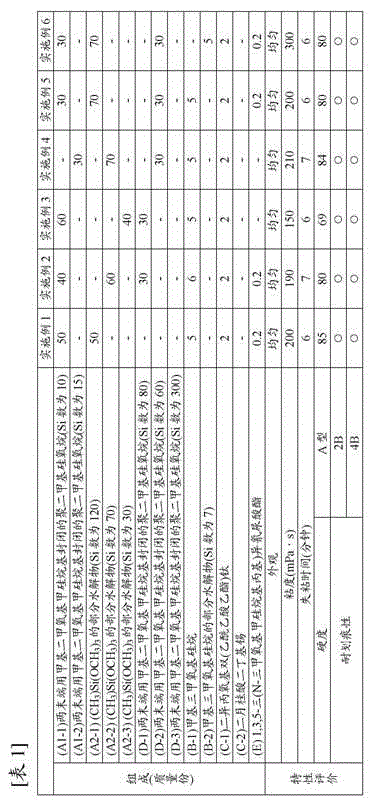Room-temperature-curable polyorganosiloxane composition and electric/electronic apparatus
A polyorganosiloxane, room temperature curing technology, applied in the field of electrical and electronic devices, can solve the problems of insufficient scratch resistance, scratch strength, deterioration of operating environment, corrosion of circuit substrates, etc., and achieves good coatability and scratch resistance. Excellent traceability
- Summary
- Abstract
- Description
- Claims
- Application Information
AI Technical Summary
Problems solved by technology
Method used
Image
Examples
Embodiment 1
[0086] In 50 parts of (A1-1) polydimethylsiloxane (viscosity of 0.013Pa·s, number of Si in the molecule is 10) with both ends of the molecular chain blocked with methyldimethoxysilyl groups , respectively blending 50 parts of (A2-1) with the formula: (CH 3 )Si(OCH 3 ) 3 The partial hydrolysis condensate of the silane compound indicated (Si number is 120), 5 parts of (B-1) methyltrimethoxysilane, 2 parts of (C-1) diisopropoxybis (ethyl acetoacetate) ) titanium and 0.2 parts of (E) 1,3,5-tris(N-trimethoxysilylpropyl) isocyanurate, uniformly mixed under moisture-proof conditions to obtain polyorganosiloxane combination.
Embodiment 2
[0088] In 40 parts of (A1-1) polydimethylsiloxane (viscosity of 0.013Pa·s, number of Si in the molecule is 10) with both ends of the molecular chain blocked with methyldimethoxysilyl groups , respectively blending 60 parts of (A2-2) with the formula: (CH 3 )Si(OCH 3 ) 3 The partial hydrolysis condensate of the silane compound represented (Si number is 70), 30 parts of (D-1) polydimethylsiloxane (viscosity 0.09Pa·s, the number of Si in the molecule is 80), 6 parts of (B-1) methyltrimethoxysilane, 2 parts of (C-1) diisopropoxybis (ethyl acetoacetate) Titanium and 0.2 parts of (E) 1,3,5-tris(N-trimethoxysilylpropyl)isocyanurate were mixed in the same manner as in Example 1 to obtain a polyorganosiloxane composition.
Embodiment 3
[0090] In 60 parts of (A1-1) polydimethylsiloxane (viscosity of 0.013Pa·s, number of Si in the molecule is 10) with both ends of the molecular chain blocked with methyldimethoxysilyl groups , respectively blending 40 parts of (A2-3) with the formula: (CH 3 )Si(OCH 3 ) 3 The partial hydrolysis condensate of the silane compound represented (Si number is 30), 30 parts of (D-1) polydimethylsiloxane (viscosity 0.09Pa·s, the number of Si in the molecule is 80), 5 parts of (B-1) methyltrimethoxysilane and 2 parts of (C-1) diisopropoxy bis (ethyl acetoacetate) Titanium was mixed in the same manner as in Example 1 to obtain a polyorganosiloxane composition.
PUM
| Property | Measurement | Unit |
|---|---|---|
| thickness | aaaaa | aaaaa |
| hardness | aaaaa | aaaaa |
Abstract
Description
Claims
Application Information
 Login to View More
Login to View More - R&D
- Intellectual Property
- Life Sciences
- Materials
- Tech Scout
- Unparalleled Data Quality
- Higher Quality Content
- 60% Fewer Hallucinations
Browse by: Latest US Patents, China's latest patents, Technical Efficacy Thesaurus, Application Domain, Technology Topic, Popular Technical Reports.
© 2025 PatSnap. All rights reserved.Legal|Privacy policy|Modern Slavery Act Transparency Statement|Sitemap|About US| Contact US: help@patsnap.com



